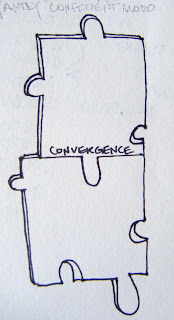Roots. Convergence. Compression/Release. Materiality. Concept.

Roots
Roots often refers to an ethnicity or style of which something originated. It insinuates the nature of something or the essence from a particular region in which to be established. "We have had enough, and to spare of the arbitrary reproduction of historic styles. In the progress of our advance from the vageries of mere architectural caprice to the dictates of structural logic, we have learned to seek concrete expression of the life of our epoch in clear and crisply forms." (pg. 519, Roth) I feel that this quote speaks directly of how the style that begun of the modernistic period. They used past styles and reproduced them in order to create a style all their own. Designers of this time had to retrogress to past periods in order to progress in their own They had to go back to the roots of design and pull from their. "Since the dawn of human symbolic thinking, architecture not only has provided utilitarian shelter but also has silently expressed how humans view themselves. In relation to the cosmos, to their Gods, and to each other. It has given formal expression to their whole social and religious natures. (pg. 519, Roth) They (designers') begun with their "roots" of utility, in order to develop a style that was expressive of the time. Not only did the roots refer to the beginnings of a style, but also to the roots of how buildings were constructed. For example, at the time of the modern era they were constructed by sticks or wood, arch construction combined with concrete, and concrete combined with wood. The roots of design for the modern era our based off of principles, such as, social changes, need for meaning, the romantic past, and that the past can be studied.

Convergence
A convergence is the point at which to points finally meet, a mixing of two different view points. " Architecture is the will of the epoch translated into space until this simple truth is clearly recognized, the new architecture will be uncertain and tentative. Until then it must remain a chaos of undirected forces. The question as to the nature of architecture is of decisive importance. It must be understood that all architecture is bound up with its own time. That it can only be manifested in living tasks and in the medium of its epoch. In no age has it been otherwise. " (pg.519, Roth) This quote explains convergence of architecture really well. It displays really well that their are two forces that are uncontrollable that come together to form on main force, or in this case one main design style. Also this quote depicts that it takes time for a convergence of any impact to occur, and also how nature plays a role in allowing epochs like this to occur. For example, the Marshall Field Warehouse, in Chicago, is indicative of the Palazzo style, however, incorporated materials and styles from the modern era. This is similar to what we are doing in studio. In studio our most recent project we are having to create a light habitat, that focuses on light in many different ways, using mdf, and paper. It becomes a convergence of two completely different materials to capture light and manipulate it in different ways.

Compression/Release
Compression is the reduction in volume, lessening of space, and further more a constricting of something with substance. Release is involved with escaping from confinement, and to remove restrictions from, and unleash from compression. Compression and release were both demonstrated on our road trip in Monticello especially. For example, in Montiecello, Jefferson used compression and release in his bedroom/ study. It was as if all the light was really compressed within his bed nook and then as your eye escaped upward toward the ceiling the room became more open and larger, and the light became released.

Materiality
Materiality is being composed of matter, and having substance. " The sleek surfaces of the modern and streamlining were fully exploited by the American motion picture industry, for the modern style matched the buoyantly confident mood of inter-war Hollywood." (pg. 114, Massey)

Concept
A concept is a general notion, a plan, intentions, allows or gives to selling or making something explicit. And it also caters to a need or philosophy. A concept is overall a collaboration of items to get one main point across. "... the art historian Heinrich Wolfflin then extended this idea to the interpretation of architecture writing in 1888, that architecture expresses the attitude to life of an epoch. ( pg. 519, Roth)
Overview:
The words roots, compression and release, convergence, materiality, and concept are all very depicting words of not only a "roadtrip" but also of telling about the past and what buildings marks each footprint of a new precedent. Roots refers to the origin of the roadtrip. The roots of this roadtrip I would have to say would be have to be Falling Water, designed by Frank Lloyd Wright. It truly is a precedent for the modernism period. To me Falling Water was about testing boundaries, and using new materials to achieve a look that simulates nature. Both Frank Lloyd Wright and Jefferson emulated materiality in their houses by incorporating light, and using materials of their time. By doing this they created a rich, inviting space that is truly illuminated by the surrounding environment. In Monticello, specifically Jefferson had a collaboration of design techniques and elements inspired from overseas. He then took those elements like the elliptical archway, and the skylight and incorporated them into his home, Monticello. Throughout our fieldtrip I realized that the overall concept for both Monticello and then Falling Water was the overreaching idea of illumination, to create legible houses for the area around the house.
![IARC: [INTERIOR ARCHITECTURE]](https://blogger.googleusercontent.com/img/b/R29vZ2xl/AVvXsEiEXTTKww7SgpqP1e6Fy3pFc5y5J9jyIdJkrjwTvsbPHglL7X4h61hsdk-bCYAWE6cXLvsHfhX7ySyKaWmOf1EDgdkf-ASYpZCwmR0jiOdy4fkhnKB4hVHkmvl3FwXBQsD0p0VSPgor8tg/s1600-r/justnicolelogo3.jpg)
No comments:
Post a Comment